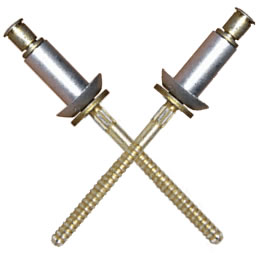
Rivets are commonly used in the aerospace and manufacturing industries. They are permanent mechanical fasteners with an expanding part — typically the tail or head — that’s used to join two or more objects. When shopping for rivets, though, you may come across several different types, such as solid rivets and semi-tubular rivets.
What Are Solid Rivets?
Solid rivets are characterized by a solid construction. They look like fat nails. Solid rivets have a mushroom-shaped head that’s connected to a smooth shank. You can use solid rivets to join two or more objects. Solid rivets are permanent mechanical fasteners that, as the name suggests, are solid.
Installing solid rivets typically requires a tool. You can use either a specialized tool, such as a compression tool or rivet gun, or you can use a hammer. When installing a solid rivet, the tool will deform the tail and head. As the solid rivet deforms, it will expand.
What Are Semi-Tubular Rivets?
Semi-tubular rivets are characterized by a small hole at the end of the shank opposite of the head. Also known simply as tubular rivets, they are permanent mechanical fasteners — just like solid rivets. Semi-tubular rivets even feature an almost identical design but with one minor difference.
Differences Between Solid and Semi-Tubular Rivets
Solid rivets and semi-tubular rivets are both used to join two or more objects, but only semi-tubular rivets feature a small hole at the end of the shank.
The hole at the end of the shank makes it easier to install semi-tubular rivets. You’ll have to apply force when installing any type of rivet. Semi-tubular rivets, though, are easier to install thanks to the small, shallow hole at the end of the shank.
How much easier are semi-tubular rivets to install than solid rivets exactly? They require about one-quarter of the force of their solid counterparts. The hole at the end of the shank encourages semi-tubular rivets to deform and expand when struck, resulting in faster and easier installation.
Another difference between solid and semi-tubular rivets is that only the tail expands with the latter. Both the head and tail of solid rivets will expand when struck with a hammer or tool. In comparison, only the tail of semi-tubular rivets will expand when struck with a hammer or tool.
In Conclusion
Rivets are available in different types. In addition to blind or hollow rivets, there are solid rivets and semi-tubular rivets. Solid rivets are entirely solid. Semi-tubular rivets, on the other hand, feature a small and shallow hole at the end of the shank. The purpose of this hole is to reduce the amount of force needed to install semi-tubular rivets.



